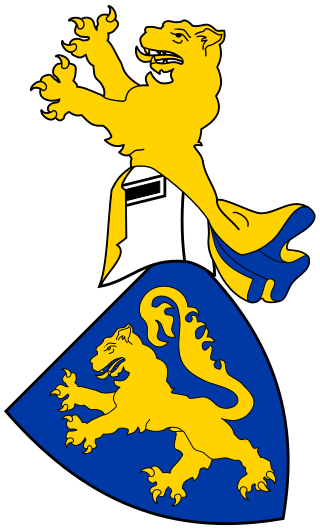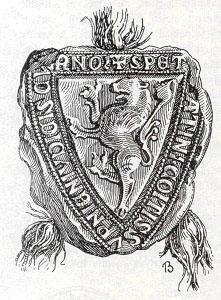Máté Csák or Matthew III Csák, also Máté Csák of Trencsén, was a Hungarian oligarch who ruled de facto independently the north-western counties of Medieval Hungary. He held the offices of master of the horse (főlovászmester) (1293–1296), palatine (nádor) and master of the treasury (tárnokmester) (1309–1311). He was able to maintain his rule over his territories even after his defeat at the Battle of Rozgony against King Charles I of Hungary. In the 19th century, he was often described as a symbol of the struggle for independence in both the Hungarian and Slovak literatures.

Vitéz Count Gyula István Cseszneky de Milvány et Csesznek was a Hungarian aristocrat, poet, cavalry officer who took part in the Hungarian reannexation of Northern Transylvania, and served as aide-de-camp to King Tomislav II of Croatia. He was also involved in anti-Nazi conspiracies and played an important role in the rescue of the European Jews.

Csesznek is a village in Zirc District, Veszprém county, Hungary. The village is known for its medieval castle.

Vyškovce nad Ipľom is a village and municipality in the Levice District in the Nitra Region of Slovakia.

The Trenčín Castle is a castle above the town of Trenčín in western Slovakia.
György Cseszneky de Milvány et Csesznek was a Hungarian aristocrat in the 16th century. Member of the Cseszneky family.
Count Mihály Cseszneky de Milvány et Csesznek was a Hungarian nobleman and 16th century border castle hero.
Count János Cseszneky de Milvány et Csesznek was a Hungarian magnate, member of the Cseszneky family.
Count Imre Cseszneky de Milvány et Csesznek (1804-1874) was a Hungarian agriculturist and patriot, born in 1804 to the impoverished Bácska branch of the Cseszneky family. In the 1830s he served as lieutenant. Later he became a talented agriculturist landowner in Szabadka area, who following the steps of Count István Széchenyi gained distinction by developing Hungarian horse breeding.

Csák was the name of a gens in the Kingdom of Hungary.
Count Mihály Mátyás Cseszneky de Milvány et Csesznek (1910–1975) was a Hungarian industrialist and nobleman, and nominal Grand Voivode of Macedonia.
Stephen (II) from the kindred Csák was a Hungarian noble who served as Wildgrave of Bakony in 1280.
Bána (Bana) was the name of a gens in the Kingdom of Hungary. According to the tradition the Cseszneky family has descended from the Bána clan.
Peter (III) from the kindred Csák was a Hungarian noble, who served as master of the horse between 1314 and 1317. He was the ancestor of the Dombai noble family.
Cseszneky is a surname of Hungarian origin.

Peter (I) from the kindred Csák was a powerful Hungarian baron, landowner and military leader, who held several secular positions during the reign of kings Stephen V and Ladislaus IV. His son and heir was the oligarch Matthew III Csák, who, based on his father and uncles' acquisitions, became the de facto ruler of his domain independently of the king and usurped royal prerogatives on his territories.
Egidius (II) from the kindred Monoszló was a Hungarian powerful baron, who served as Master of the treasury from 1270 to 1272 and from 1274 to 1275. He was a loyal supporter of Stephen V of Hungary from his ducal years.

Hahót or Hahót–Buzád was the name of a gens in the Kingdom of Hungary, several prominent secular dignitaries came from this kindred. The last noble family, which originated from the kindred, became extinct in 1849.
Hahold (IV) from the kindred Hahót was a Hungarian noble.

The Castle of Csesznek lies in the Bakony between Győr and Zirc in the village of Csesznek. The castle was constructed after the Mongol invasion of Europe around 1263 in a period where many castles were built. The first castle was built by Jakab Cseszneky of the Bána clan. The first written mention of the castle is in a document from 1281 that gives Jakab Cseszneky's sons joint ownership of the castle. In 1315 the Csák clan conquered the castle. In 1392 Sigismund gave the castle and 31 surrounding villages to the Garai family. The castle was owned by the Garai family until 1482. Then Matthias Corvinus donated the castle to Stephen Zápolya.